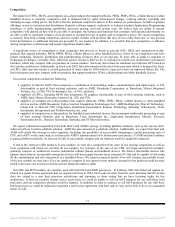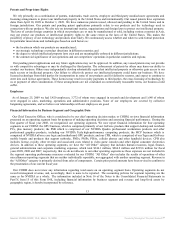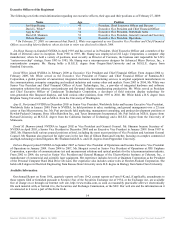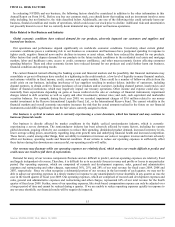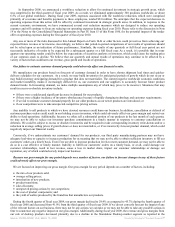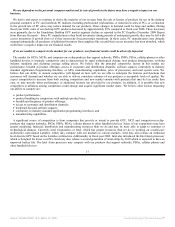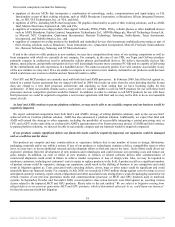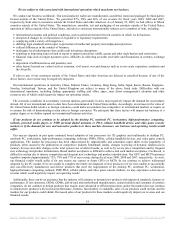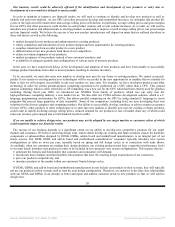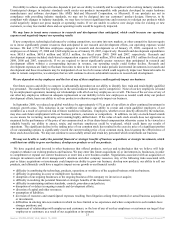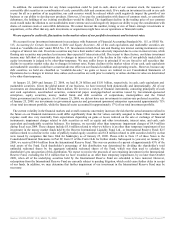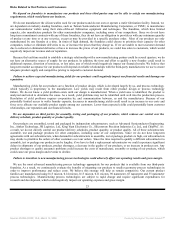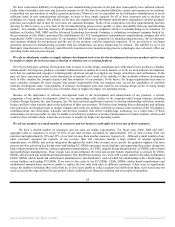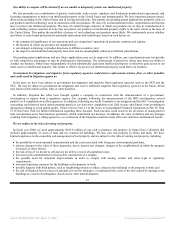NVIDIA 2009 Annual Report Download - page 25
Download and view the complete annual report
Please find page 25 of the 2009 NVIDIA annual report below. You can navigate through the pages in the report by either clicking on the pages listed below, or by using the keyword search tool below to find specific information within the annual report.
Our ability to achieve design wins also depends in part on our ability to identify and be compliant with evolving industry standards.
Unanticipated changes in industry standards could render our products incompatible with products developed by major hardware
manufacturers and software developers like AMD, Intel and Microsoft Corporation, or Microsoft. If our products are not in
compliance with prevailing industry standards, we may not be designed into our customers’ product designs. However, to be
compliant with changes to industry standards, we may have to invest significant time and resources to redesign our products which
could negatively impact our gross margin or operating results. If we are unable to achieve new design wins for existing or new
customers, we may lose market share and our operating results would be negatively impacted.
We may have to invest more resources in research and development than anticipated, which could increase our operating
expenses and negatively impact our operating results.
If new competitors, technological advances by existing competitors, our entry into new markets, or other competitive factors require
us to invest significantly greater resources than anticipated in our research and development efforts, our operating expenses would
increase. We had 3,772 full-time employees engaged in research and development as of January 25, 2009, compared to 3,255
employees as of January 27, 2008 and 2,668 employees as of January 28, 2007, respectively. Research and development expenditures
were $855.9 million, $691.6 million and $553.5 million, for fiscal years 2009, 2008 and 2007, respectively. Research and
development expenses included stock-based compensation expense of $98.0 million, $76.6 million and $70.1 million for fiscal years
2009, 2008 and 2007, respectively. If we are required to invest significantly greater resources than anticipated in research and
development efforts without a corresponding increase in revenue, our operating results could further decline. Research and
development expenses are likely to fluctuate from time to time to the extent we make periodic incremental investments in research and
development and these investments may be independent of our level of revenue which could negatively impact our financial results. In
order to remain competitive, we anticipate that we will continue to devote substantial resources to research and development.
We are dependent on key employees and the loss of any of these employees could negatively impact our business.
Our future success and ability to compete is substantially dependent on our ability to identify, hire, train and retain highly qualified
key personnel. The market for key employees in the semiconductor industry can be competitive. None of our key employees is bound
by an employment agreement, meaning our relationships with all of our key employees are at will. The loss of the services of any of
our other key employees without an adequate replacement or our inability to hire new employees as needed could delay our product
development efforts, harm our ability to sell our products or otherwise negatively impact our business.
In September 2008, we reduced our global workforce by approximately 6.5% as part of our efforts to allow continued investment in
strategic growth areas. This reduction in our workforce may impair our ability to recruit and retain qualified employees of our
workforce as a result of a perceived risk of future workforce reductions. Employees, whether or not directly affected by the reduction,
may also seek future employment with our business partners, customers or competitors. In addition, we rely on stock-based awards
as one means for recruiting, motivating and retaining highly skilled talent. If the value of such stock awards does not appreciate as
measured by the performance of the price of our common stock or if our share-based compensation otherwise ceases to be viewed as a
valuable benefit, our ability to attract, retain, and motivate employees could be weakened, which could harm our results of
operations. The significant decline in the trading price of our common stock has resulted in the exercise price of a significant portion
of our outstanding options to significantly exceed the current trading price of our common stock, thus lessening the effectiveness of
these stock-based awards. We may not continue to successfully attract and retain key personnel which would harm our business.
We may not be able to realize the potential financial or strategic benefits of business acquisitions or strategic investments, which
could hurt our ability to grow our business, develop new products or sell our products.
We have acquired and invested in other businesses that offered products, services and technologies that we believe will help
expand or enhance our existing products and business. We may enter into future acquisitions of, or investments in, businesses, in order
to complement or expand our current businesses or enter into a new business market. Negotiations associated with an acquisition or
strategic investment could divert management’s attention and other company resources. Any of the following risks associated with
past or future acquisitions or investments could impair our ability to grow our business, develop new products, our ability to sell our
products, and ultimately could have a negative impact on our growth or our financial results:
• difficulty in combining the technology, products, operations or workforce of the acquired business with our business;
• difficulty in operating in a new or multiple new locations;
• disruption of our ongoing businesses or the ongoing business of the company we invest in or acquire;
• difficulty in realizing the potential financial or strategic benefits of the transaction;
• difficulty in maintaining uniform standards, controls, procedures and policies;
• disruption of or delays in ongoing research and development efforts;
• diversion of capital and other resources;
• assumption of liabilities;
• diversion of resources and unanticipated expenses resulting from litigation arising from potential or actual business acquisitions
or investments;
• difficulties in entering into new markets in which we have limited or no experience and where competitors in such markets have
stronger positions; and
• impairment of relationships with employees and customers, or the loss of any of our key employees or customers our target’s key
employees or customers, as a result of our acquisition or investment.
21
Source: NVIDIA CORP, 10-K, March 13, 2009 Powered by Morningstar® Document Research℠


